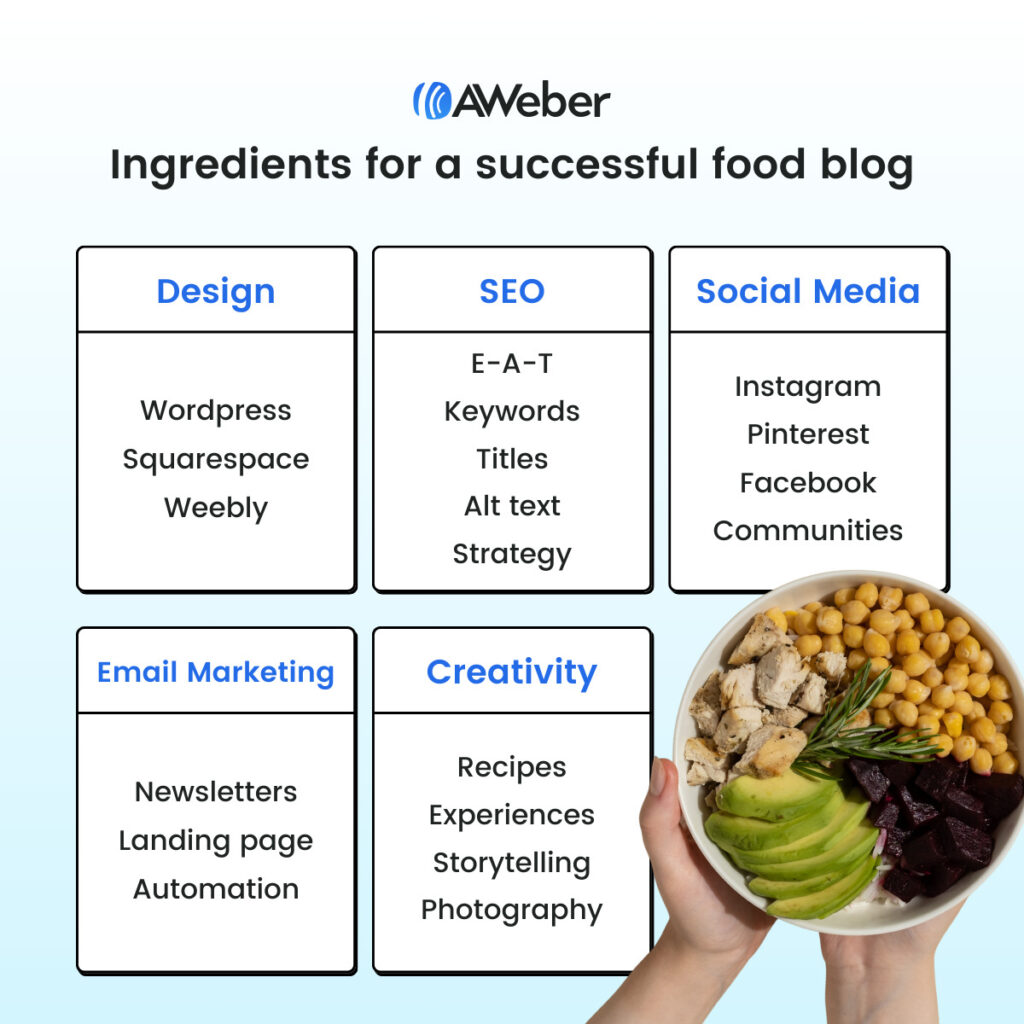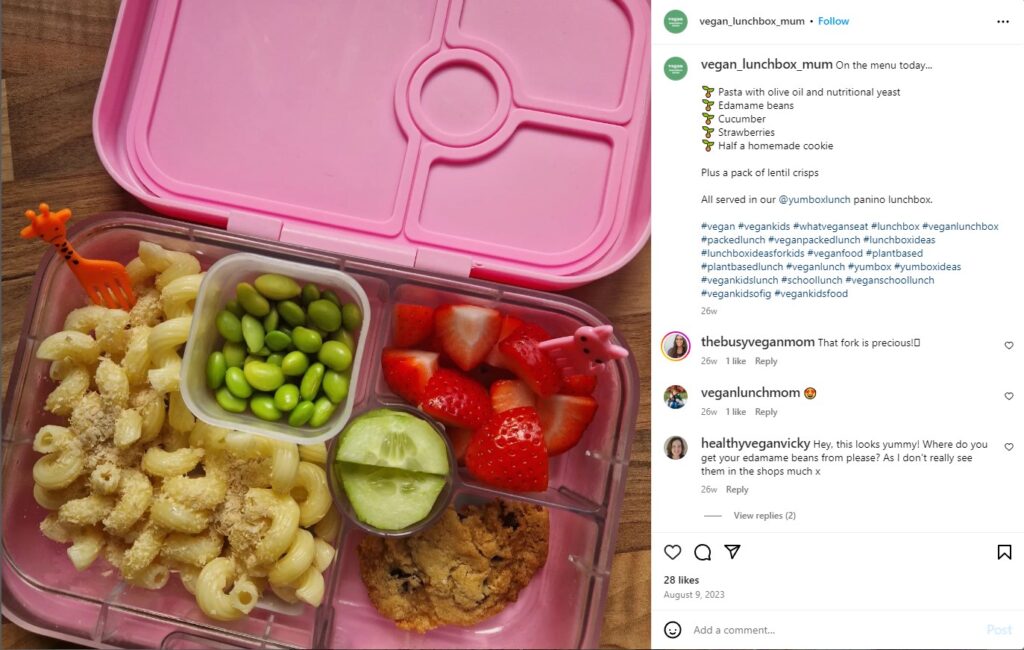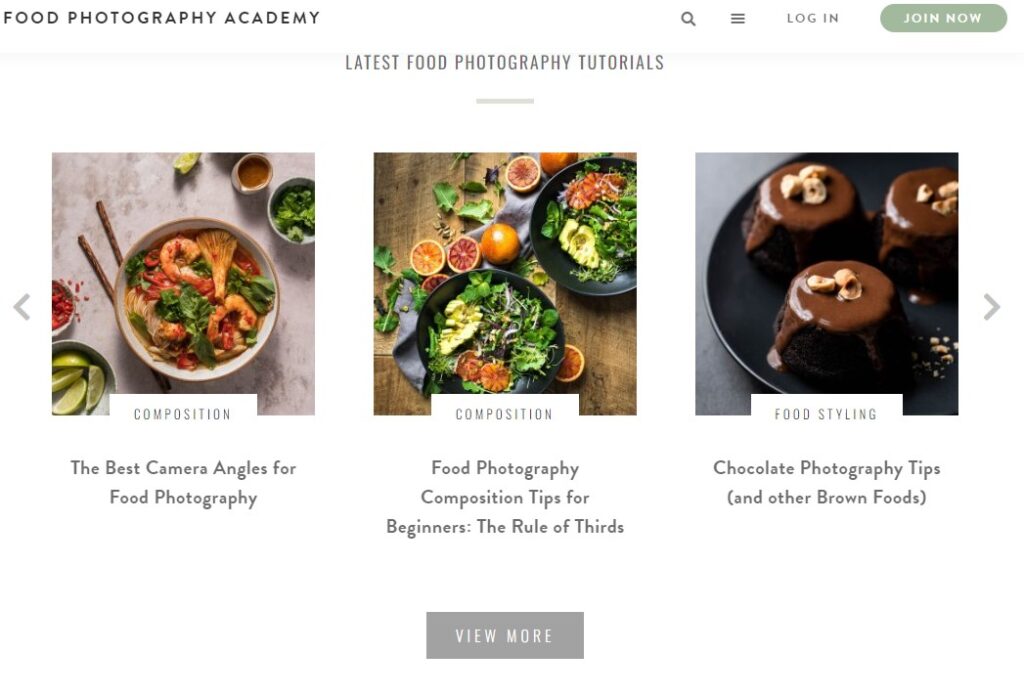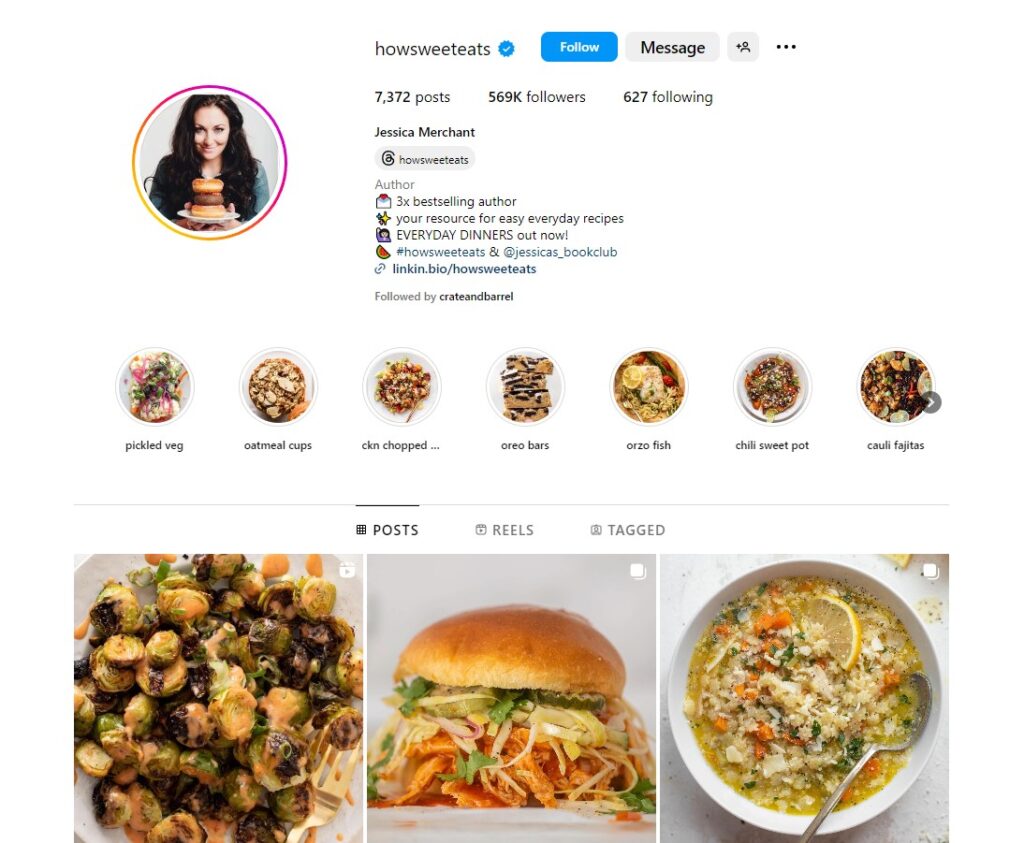How to start a food blog: Recipe for success
By Rhonda Bradley March 12, 2024
You have a passion for food and want to share it with the world.
Blogging can give you a way to express your love for all things culinary and connect you with a global network of like-minded people.
It also boosts your credibility as a chef or author.
And it gives you another way to earn income and promote your books and products to a wider audience.
Plus, there’s all the food.
But getting started as a food blogger might sound complicated, especially if you’ve never launched a website before. There are a lot of steps and decisions involved, and you may find yourself wondering “Where do I begin?”
If you want to start your own food blog but need a bit of guidance on how to do it, you’re in the right place.
This recipe for food blogging success walks you through every step you need to know to launch and promote your new site.
Recipe for becoming a food blogger
This recipe is a roadmap for anyone who wants to start a food blog. It includes choosing your niche, setting up a domain, designing a website, promoting your blog, and much more!
Servings: 1 Successful Food Blog
Preparation Time: Varies
Cook Time: A lifetime of passion and dedication
Ingredients for a successful food blog
To create a delicious food blog, begin with a clear niche, catchy name, and user-friendly blogging platform.

An attractive design and high-quality photos, plus some basic search engine optimization, can help drive traffic from Google and social media to your blog.
- 1 clear niche (vegan, desserts, cultural cuisines, etc.)
- 1 catchy blog name
- 1 blogging platform
- 1 domain and hosting service (optional but recommended for a professional touch)
- A dash of website design (user-friendly and appealing)
- 3-5 original and tested recipes to start
- A cup of high-quality food photos
- A tablespoon of SEO knowledge
- A generous portion of social media presence
- Regular pinches of patience and perseverance
- An endless supply of creativity and passion
Find out how to pull all your blog “ingredients” together in the instructions below!
Instructions for starting your food blog
Below are step-by-step instructions for getting your food blog off to a great start.
Food blogging prep work: define your purpose
Perhaps you want to share your culture through food. Maybe you have a love for vegan foods or a flair for keto, low-calorie, or other health-related categories of cuisine. Or you might be a talented chef hoping to share your recipes and cooking techniques with the world.
Whether you want to do something as simple as sharing grandma’s recipes or as adventurous as experiencing the life of a traveling food blogger, defining your blog’s purpose is the best place to start.
Take a few moments to document your goals, motivation, and backstory.
Write down your answers to the following questions:
- Why do you want to start a food blog?
- What kind of food blog would you like to start?
- What’s your story — when did your love for food begin, and who are the people who inspired you along the way?
- What’s the #1 goal of your food blog? This might be anything from personal enjoyment to profits to connecting with other food bloggers. Pinpoint your driving motivation and write it down.
Putting your desires, motivations, and vision down on paper can help define your purpose and guide your decisions for years to come.
Ready to get started? In the guide below, we show you how to develop your passion for food into a successful food blog.
Step 1: Find your flavor (niche selection)
Begin your blogging journey by deciding what type of food blog you want to create.
Are you leaning towards a specific cuisine, dietary preference, or food-related adventures? Your niche will guide the content you create, so make sure it’s something you’re passionate about.
You’ll enjoy a better chance of getting discovered in the search engines when you choose a specific niche. Niching can help your blog gain popularity quicker because it narrows the pool of competition.
For example, you would face a lot of well-established competition with a niche like “vegan recipes.” But if you narrow this description, you’re likely to get more traffic from Google and on social media.
Instagram’s Vegan_Lunch_Mom specializes in vegan lunches for kids. Her page is one of the top search results for “vegan lunch” on Instagram, thanks to its specific description. Google works similarly, providing more ranking opportunities for your blog in niches with less competition.

Step 2: Mix in a memorable blog name
Brainstorm to come up with a blog name that’s catchy, relevant to your niche, and easy to remember. Your blog name should give potential readers a taste of what your blog is about while reflecting your personality.
Stuck for ideas? Try the Wix blog name generator for new ideas!

Step 3: Prepare your kitchen (setup your blog)
Next, you’ll want to find the best blogging platform to fit your style and experience, such as WordPress, Squarespace, or Weebly.
For a more professional presentation, consider purchasing a domain name and hosting for your blog.
Customize your blog’s design with a theme, colors, and fonts that are as appetizing as your food photography.
Step 4: Whip Up your first blog posts
Create your initial content, focusing on quality and uniqueness. Start with 3-5 posts that showcase your personal food style and niche.
Proofread your posts before you publish. You might even ask a friend to review your first posts and offer feedback!
If you’re publishing recipes, make sure each one is well-tested and includes clear, concise instructions.
Step 5: Garnish with gorgeous photos
As a food blogger, good photography is your door to the world.
The quality of your photography plays a significant role in the popularity of your blog and social media channels.
For example, Mama Gourmand, a gluten-free family food blogger, showcases beautiful photographs that are well-lit, crystal clear, and compelling.

If you’re new to food photography, you can learn the basics from other successful food bloggers or take a food photography class on a site like Udemy or Food Photography Academy.

Your photos should make mouths water, so practice taking shots with good lighting, interesting angles, and minimal but effective styling.
Step 6: Season with search engine optimization (SEO)
Sprinkle your posts with SEO blogging strategies to help them get found by people searching for blogs like yours on Google.
Use relevant keywords, optimize your images, and create catchy titles that will draw readers in.
If you’re new to SEO for food blogs or could benefit from a quick refresher, the 10-minute YouTube tutorial SEO-friendly recipe posts by Real Website Hints will get you up to speed.
Step 7: Serve up on social media
Share your photographs, videos, and expert tips on social media platforms.
Instagram is a top choice for food bloggers. Pinterest is perfect for bloggers who enjoy posting recipes. And if you hope to start a private online community someday, Facebook is an excellent platform for groups.
On any social media channel, engaging with your followers is important to building an active audience. You can engage by responding to comments and asking for feedback.
Then, turn your readers and social media followers into email subscribers so you can keep them coming back for more.
Step 8: Marinate with email marketing
Email marketing is one of the best ways to engage with your readers since it allows you to communicate directly with them.
Sending a weekly newsletter can help boost your social media following, drive more traffic to your blog, build loyalty with your audience, and provide you with additional monetization opportunities.
Email marketing is all about nurturing a community of dedicated readers, which can significantly improve the success of your blog.
Encourage people to subscribe to your mailing list by including a form or popup on your blog!
For example, FedandFit food and fitness blog encourages visitors to subscribe to its blog by including a subscription form at the top of its category pages.

Step 9: Let it simmer
Understand that success won’t happen overnight. Keep adding fresh content on a consistent schedule, refining your photography, communications, and marketing skills along the way.
Regularly monitor your blog analytics to discover which posts are driving people to your blog and keeping them on your site the longest. Then, create more like those!
Step 10: Taste and adjust
As your blog grows, listen to your audience and adjust your content accordingly. Try new types of posts, experiment with video recipes, and always be open to feedback on how to improve your blog.
Step 11: Don’t forget to E-A-T
E-A-T stands for Experience, Authoritativeness, and Trustworthiness. It’s a concept used by Google to evaluate the quality of content on the web.
For bloggers, E-A-T matters because it influences how well your content ranks in search results.
Here are some tips on how to incorporate E-A-T into your blog writing:
- Write in first-person narrative and share your stories, experiences, and lessons learned along the way.
- Showcase your expertise by providing in-depth and accurate information.
- Build trust through transparent, honest content and by collaborating with other bloggers or businesses for special events and unique content.
High E-A-T scores can lead to better search rankings and increased traffic to your blog, making it an important ingredient to successful blogging.
Serving suggestion: One heaping portion of marketing and promotions
Once your blog is up and running — and you’ve got the hang of blogging on a consistent basis — you’ll be ready to step up your marketing efforts.
Using the same methods mentioned above (email marketing, social media, and SEO), you can focus on promoting your food blog in more ambitious ways.
For example, you can create a landing page that offers a free download to people who subscribe to your email newsletter. The free download, called “Lead generation content,” could be a recipe book, food traveling tips, or another type of guide that offers high value to your target audience.
If it sounds like a lot, here’s some great news: you can automate most of your email and marketing tasks. For example, AWeber has a blog automation feature that automatically sends an email to your audience when you publish a new blog or this email can be scheduled once a day, weekly or monthly. The choice is yours.
AWeber will scan your blog and pull into the email the information for your new blog. You don’t need to do anything other than watch your blog traffic increase.
Most food bloggers embrace Instagram as a way to drive more traffic to their food blogs.
For example, food blogger and bestselling author Jessica Merchant frequently posts foodie Reels on her page HowSweetEats.

With its focus on high-quality visuals, Instagram is a great place to promote your food blog and develop a supportive community.
Food blogging FAQs
How can you make money with food blogging?
You can make money with food blogging through advertising, sponsored content, affiliate marketing, selling digital products like books or courses, and hosting cooking classes or workshops.
What kind of photography equipment do I need to get started with food blogging?
To get started with food blogging, you need a good quality camera (DSLR or a smartphone with a high-quality camera), a tripod, and natural lighting or a basic artificial light setup.
Before you invest in photography equipment, consider taking one of the food blogging photography courses mentioned above. Your instructor will probably have tips on the best brands and models. They may also share some advice on how to save money when investing in photography equipment.
What are the Pros and Cons of food blogging?
Food blogging offers the opportunity to share your culinary passions, connect with a global audience, and earn an income doing something you love.
However, it also requires patience, consistency, and an investment of your time to grow and nurture your blog and audience.
Getting your food blog started
To begin, you’ll make decisions about your blog’s name, branding, and web design. And you’ll make decisions on what platforms, tools, and equipment you use to start blogging.
Once you get past the technical aspects of blogging, you’ll enjoy the creative side.
Your food blog should reflect who you are as a person and what you’re passionate about.
Remember to keep your list of personal goals (created in the “Prep work” section above) nearby to help you make decisions that pave the way toward a blog that’s as unique and creative as you are.
At AWeber, we think of all the things. Like the fact that you’re a food blogger and probably don’t want to spend a lot of time on marketing.
We provide you with everything you need to create professional emails and landing pages in minutes. And we put it all inside a beautiful drag-and-drop interface that’s super simple and easy to use.
Why not open a free AWeber account now so you’re prepared to greet your new audience on launch day?
Bon Appétit! 🍴
 87% off ends soon!
87% off ends soon! 
